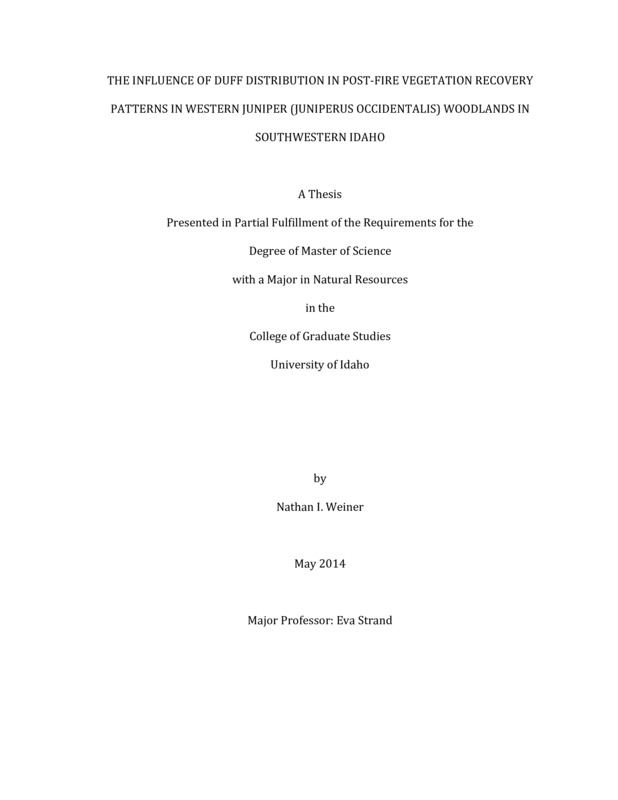INFLUENCE OF DUFF DISTRIBUTION IN POST-FIRE VEGETATION RECOVERY PATTERNS IN WESTERN JUNIPER (JUNIPERUS OCCIDENTALIS) WOODLANDS IN SOUTHWESTER IDAHO
Weiner, Nathan. (2014). INFLUENCE OF DUFF DISTRIBUTION IN POST-FIRE VEGETATION RECOVERY PATTERNS IN WESTERN JUNIPER (JUNIPERUS OCCIDENTALIS) WOODLANDS IN SOUTHWESTER IDAHO. Theses and Dissertations Collection, University of Idaho Library Digital Collections. https://www.lib.uidaho.edu/digital/etd/items/weiner_idaho_0089m_10180.html
- Title:
- INFLUENCE OF DUFF DISTRIBUTION IN POST-FIRE VEGETATION RECOVERY PATTERNS IN WESTERN JUNIPER (JUNIPERUS OCCIDENTALIS) WOODLANDS IN SOUTHWESTER IDAHO
- Author:
- Weiner, Nathan
- Date:
- 2014
- Program:
- Natural Resources
- Subject Category:
- Range management
- Abstract:
-
Woody plant expansion is a global phenomenon that alters the spatial distribution of nutrients, biomass, and fuels in affected ecosystems. Altered fuel patterns across the landscape influences ecological processes including fire behavior, fire effects, and can impact post-fire plant recovery. The purpose of this study was to determine how accumulations of ground fuels in maturing western juniper
(Juniperus occidentalis ssp. occidentalis) woodlands affect post-fire species response as well as demonstrate new methods in wavelet analysis to quantify landscape scale patterns of fuel loading. Sampling and analysis was conducted across environmental gradients following the Tongue-Crutcher Wildfire Complex in 2007 in order to determine what conditions were most influential in vegetation recovery. Of the multiple environmental gradients analyzed, duff depth and fire severity were determined to be the two most influential factors affecting post-fire vegetation response. Decreasing species diversity was represented along the increasing duff depth gradient as well as the exclusion of some species at certain depths. Species response grouped by fire severity revealed significant presence of cheatgrass(Bromus tectorum) in low severity sites and a dominant presence of snowbrush ceanothus(Ceanothus velutinus) in higher severity sites. Native perennial bunch grass cover was greater in unburned areas compared to burned areas of the landscape. Landscape scale representations of fuel loading for duff/litter were derived from the recognition of individual crowns using a discrete wavelet transformation. Determining sub-crown surface fuel characteristics on a landscape scale make it possible to predict future patterns and processes as they relate to vegetation recovery and/or fire severity components. - Description:
- masters, M.S., Natural Resources -- University of Idaho - College of Graduate Studies, 2014
- Major Professor:
- Strand, Eva
- Committee:
- Smith, Alistair; Bunting, Stephen
- Defense Date:
- 2014
- Identifier:
- Weiner_idaho_0089M_10180
- Type:
- Text
- Format Original:
- Format:
- application/pdf
- Rights:
- In Copyright - Educational Use Permitted. For more information, please contact University of Idaho Library Special Collections and Archives Department at libspec@uidaho.edu.
- Standardized Rights:
- http://rightsstatements.org/vocab/InC-EDU/1.0/

